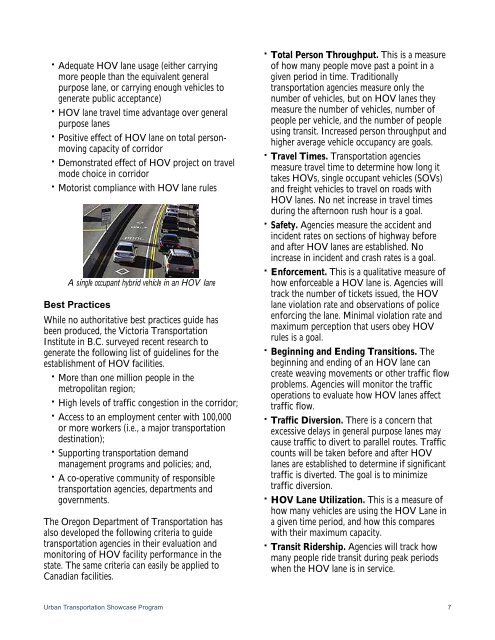High Occupancy Vehicle Lanes in Canada
High Occupancy Vehicle Lanes in Canada
High Occupancy Vehicle Lanes in Canada
Create successful ePaper yourself
Turn your PDF publications into a flip-book with our unique Google optimized e-Paper software.
• Adequate HOV lane usage (either carry<strong>in</strong>g<br />
more people than the equivalent general<br />
purpose lane, or carry<strong>in</strong>g enough vehicles to<br />
generate public acceptance)<br />
• HOV lane travel time advantage over general<br />
purpose lanes<br />
• Positive effect of HOV lane on total personmov<strong>in</strong>g<br />
capacity of corridor<br />
• Demonstrated effect of HOV project on travel<br />
mode choice <strong>in</strong> corridor<br />
• Motorist compliance with HOV lane rules<br />
A s<strong>in</strong>gle occupant hybrid vehicle <strong>in</strong> an HOV lane<br />
Best Practices<br />
While no authoritative best practices guide has<br />
been produced, the Victoria Transportation<br />
Institute <strong>in</strong> B.C. surveyed recent research to<br />
generate the follow<strong>in</strong>g list of guidel<strong>in</strong>es for the<br />
establishment of HOV facilities.<br />
• More than one million people <strong>in</strong> the<br />
metropolitan region;<br />
• <strong>High</strong> levels of traffic congestion <strong>in</strong> the corridor;<br />
• Access to an employment center with 100,000<br />
or more workers (i.e., a major transportation<br />
dest<strong>in</strong>ation);<br />
• Support<strong>in</strong>g transportation demand<br />
management programs and policies; and,<br />
• A co-operative community of responsible<br />
transportation agencies, departments and<br />
governments.<br />
The Oregon Department of Transportation has<br />
also developed the follow<strong>in</strong>g criteria to guide<br />
transportation agencies <strong>in</strong> their evaluation and<br />
monitor<strong>in</strong>g of HOV facility performance <strong>in</strong> the<br />
state. The same criteria can easily be applied to<br />
Canadian facilities.<br />
• Total Person Throughput. This is a measure<br />
of how many people move past a po<strong>in</strong>t <strong>in</strong> a<br />
given period <strong>in</strong> time. Traditionally<br />
transportation agencies measure only the<br />
number of vehicles, but on HOV lanes they<br />
measure the number of vehicles, number of<br />
people per vehicle, and the number of people<br />
us<strong>in</strong>g transit. Increased person throughput and<br />
higher average vehicle occupancy are goals.<br />
• Travel Times. Transportation agencies<br />
measure travel time to determ<strong>in</strong>e how long it<br />
takes HOVs, s<strong>in</strong>gle occupant vehicles (SOVs)<br />
and freight vehicles to travel on roads with<br />
HOV lanes. No net <strong>in</strong>crease <strong>in</strong> travel times<br />
dur<strong>in</strong>g the afternoon rush hour is a goal.<br />
• Safety. Agencies measure the accident and<br />
<strong>in</strong>cident rates on sections of highway before<br />
and after HOV lanes are established. No<br />
<strong>in</strong>crease <strong>in</strong> <strong>in</strong>cident and crash rates is a goal.<br />
• Enforcement. This is a qualitative measure of<br />
how enforceable a HOV lane is. Agencies will<br />
track the number of tickets issued, the HOV<br />
lane violation rate and observations of police<br />
enforc<strong>in</strong>g the lane. M<strong>in</strong>imal violation rate and<br />
maximum perception that users obey HOV<br />
rules is a goal.<br />
• Beg<strong>in</strong>n<strong>in</strong>g and End<strong>in</strong>g Transitions. The<br />
beg<strong>in</strong>n<strong>in</strong>g and end<strong>in</strong>g of an HOV lane can<br />
create weav<strong>in</strong>g movements or other traffic flow<br />
problems. Agencies will monitor the traffic<br />
operations to evaluate how HOV lanes affect<br />
traffic flow.<br />
• Traffic Diversion. There is a concern that<br />
excessive delays <strong>in</strong> general purpose lanes may<br />
cause traffic to divert to parallel routes. Traffic<br />
counts will be taken before and after HOV<br />
lanes are established to determ<strong>in</strong>e if significant<br />
traffic is diverted. The goal is to m<strong>in</strong>imize<br />
traffic diversion.<br />
• HOV Lane Utilization. This is a measure of<br />
how many vehicles are us<strong>in</strong>g the HOV Lane <strong>in</strong><br />
a given time period, and how this compares<br />
with their maximum capacity.<br />
• Transit Ridership. Agencies will track how<br />
many people ride transit dur<strong>in</strong>g peak periods<br />
when the HOV lane is <strong>in</strong> service.<br />
Urban Transportation Showcase Program 7
















